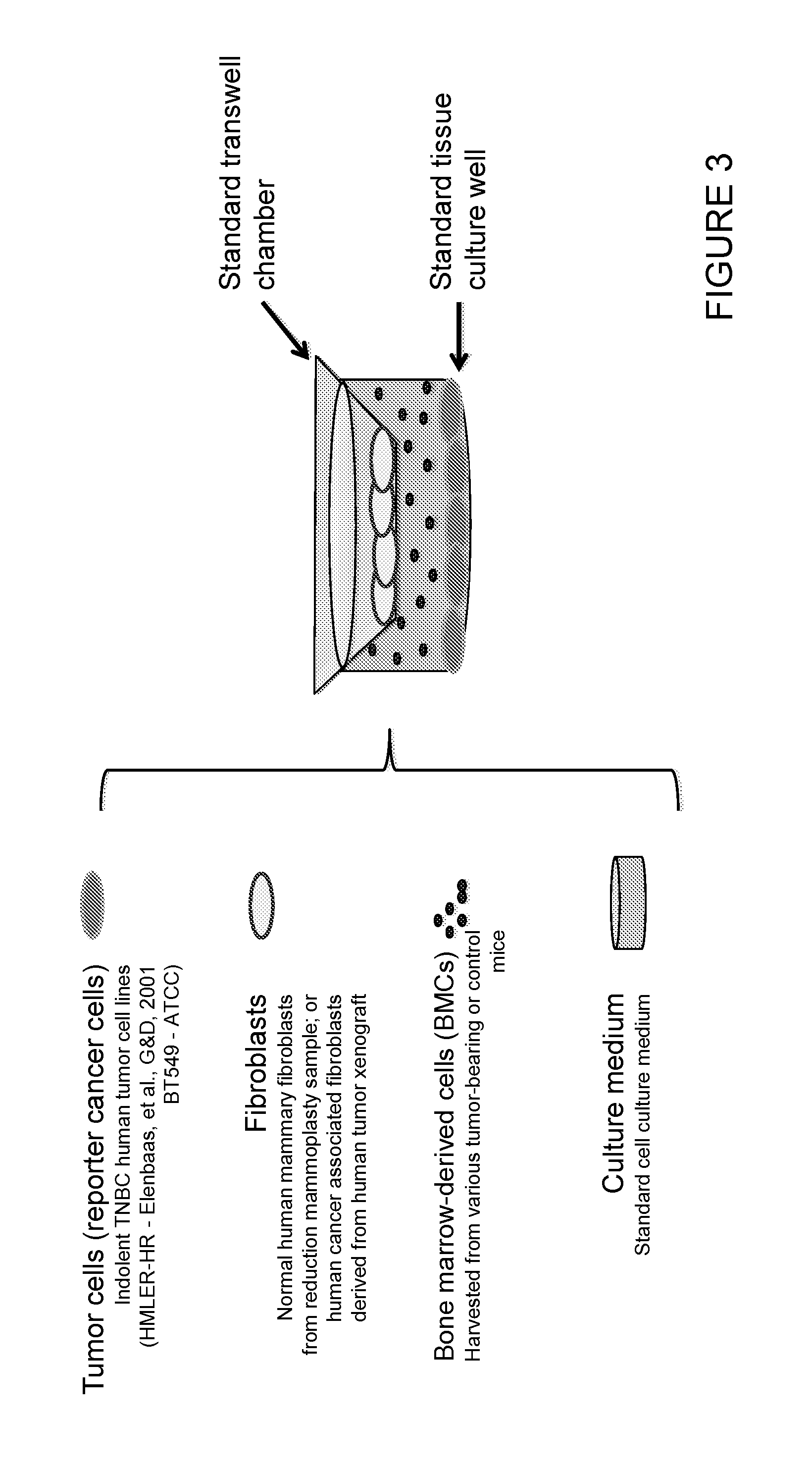Functional assay for cancer recurrence and malignant potential
a cancer and functional assay technology, applied in the field of cancer recurrence, malignancy development, cancer drug screening and surveillance for resistance to cancer drug therapy, can solve the problems of insufficient to enhance responding tumor malignancy, difficult to accurately and difficult to predict which cancer patients are likely to relapse or benefit from preemptive therapy
- Summary
- Abstract
- Description
- Claims
- Application Information
AI Technical Summary
Benefits of technology
Problems solved by technology
Method used
Image
Examples
example
Example 1
An In Vitro Functional Assay to Predict Breast Cancer Recurrence
[0376]The main goal here is to generation of an in vitro test of the tumor-promoting capability of the host systemic environment. The inventors have shown previously that tumor-supportive host systemic environment is defined by elevated plasma levels of osteopontin and circulating pro-tumorigenic bone marrow-derived cells. It is known that the pro-tumorigenic BMCs can be unique to hosts bearing certain instigating tumors. The inventors set out to define the properties of instigating tumors that operate in this fashion. In other words, these BMCs are not found in cancer-free hosts or hosts bearing non-instigating tumors (defined as tumors that grow aggressively, but do not have systemic instigating capability).
[0377]It has also been shown that once recruited to the sites where indolent tumors reside, the pro-tumorigenic bone marrow-derived cells activate tissue fibroblasts to confer upon them a tumor-promoting m...
example 2
Understanding how Tumor Microenvironment Governs Breast Cancer Plasticity and Malignancy In Vitro
[0386]Breast tumors are classified based on molecular and hormone receptor status. Two of these categories include triple negative (TNBC, ER− / PR− / HER2−) and luminal breast cancer (LBC, HER2+ / PR+ / ER+). Breast cancer recurrence rates are variable, suggesting that tumor cells disseminate from primary sites at an early stage but remain indolent for extended periods of time before progressing to symptomatic disease. It is thought that conventional therapies might select for highly malignant cells, called cancer stem cells (CSC), that are resistant to treatment and fuel tumor initiation, giving rise to secondary tumors. However, little is known about the mechanisms that cause these indolent tumors to grow into malignant disease. The inventors have previously reported that certain human carcinomas (“instigators”) facilitate the growth of otherwise indolent tumor cells (“responders”) located at ...
example 3
Triple-Negative Breast Cancers Establish a Systemic Environment that Programs Malignancy Via EGF and IGF-1
[0391]Materials and Methods
[0392]Cell Lines
[0393]HMLER hygro-H-rasV12 (HMLER-HR), BPLER, and MCF7-Ras human mammary epithelial tumor cells have been previously described (Elenbaas et al., 2001; Hahn et al., 1999; ince et al., 2007; Orimo et al., 2005).
[0394]Cell Culture Conditions
[0395]HMLER-HR cells were maintained in DMEM-F12 (1:1) medium, supplemented with 5% calf serum, 10 ng / ml human recombinant EGF (Sigma E9644), 10 μg / ml insulin (Sigma 19278), 1 μg / ml hydrocortisone (Sigma 110888) and 1% penicillin-streptomycin. BPLER cells were maintained in WIT Medium (STEMGENT), and MCF7-Ras cells in DMEM media (Thermo Scientific) supplemented with 10% heat inactivated FBS (GIBCO), and 1% penicillin-streptomycin. BT549 cells were maintained in RPMI medium supplemented with 10% FBS.
[0396]Animals and Tumor Xenografts
[0397]Female Nude mice were purchased from Taconic (Hudson, N.Y.). All e...
PUM
| Property | Measurement | Unit |
|---|---|---|
| Electrical resistance | aaaaa | aaaaa |
Abstract
Description
Claims
Application Information
 Login to View More
Login to View More - R&D
- Intellectual Property
- Life Sciences
- Materials
- Tech Scout
- Unparalleled Data Quality
- Higher Quality Content
- 60% Fewer Hallucinations
Browse by: Latest US Patents, China's latest patents, Technical Efficacy Thesaurus, Application Domain, Technology Topic, Popular Technical Reports.
© 2025 PatSnap. All rights reserved.Legal|Privacy policy|Modern Slavery Act Transparency Statement|Sitemap|About US| Contact US: help@patsnap.com



